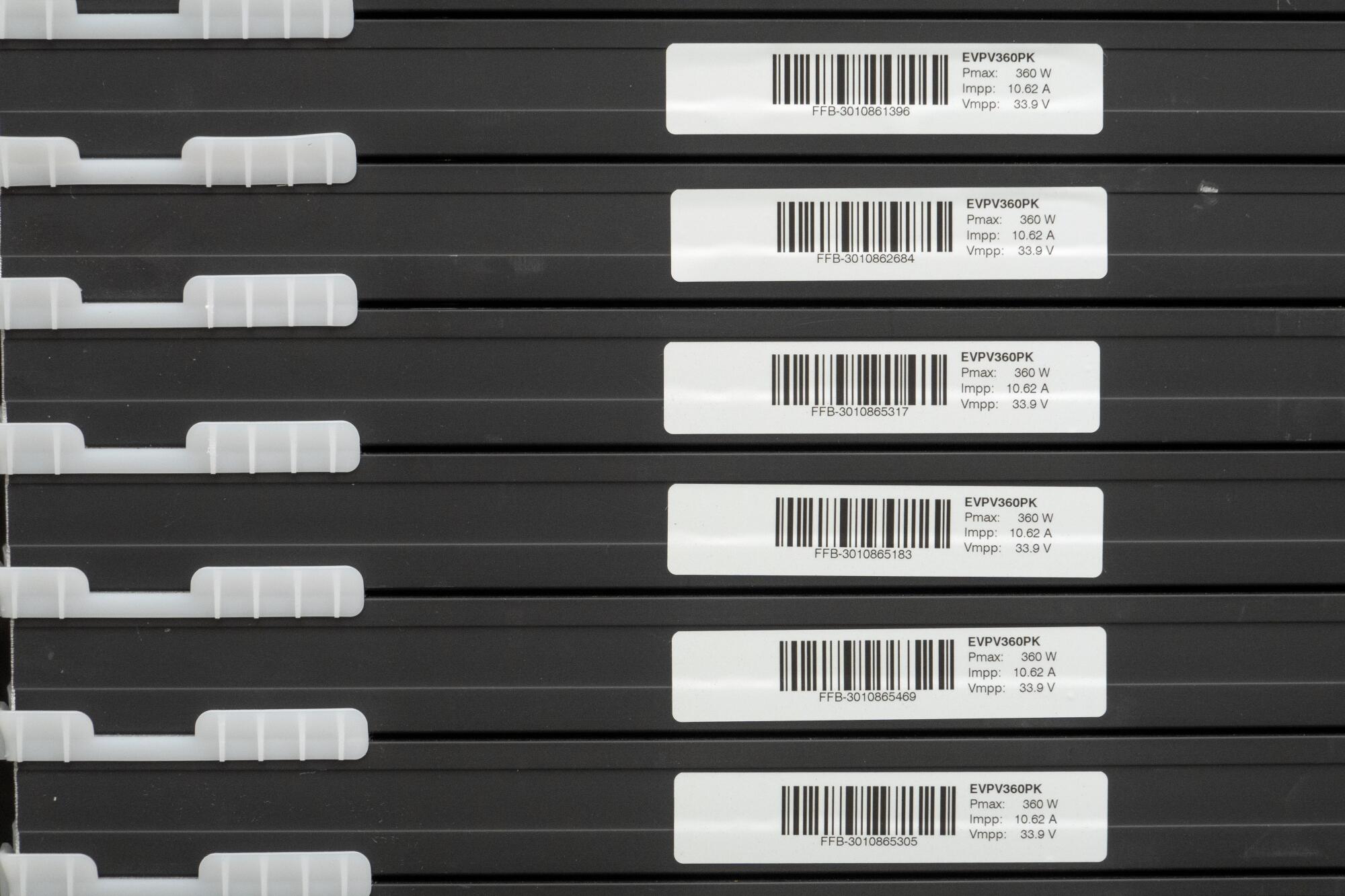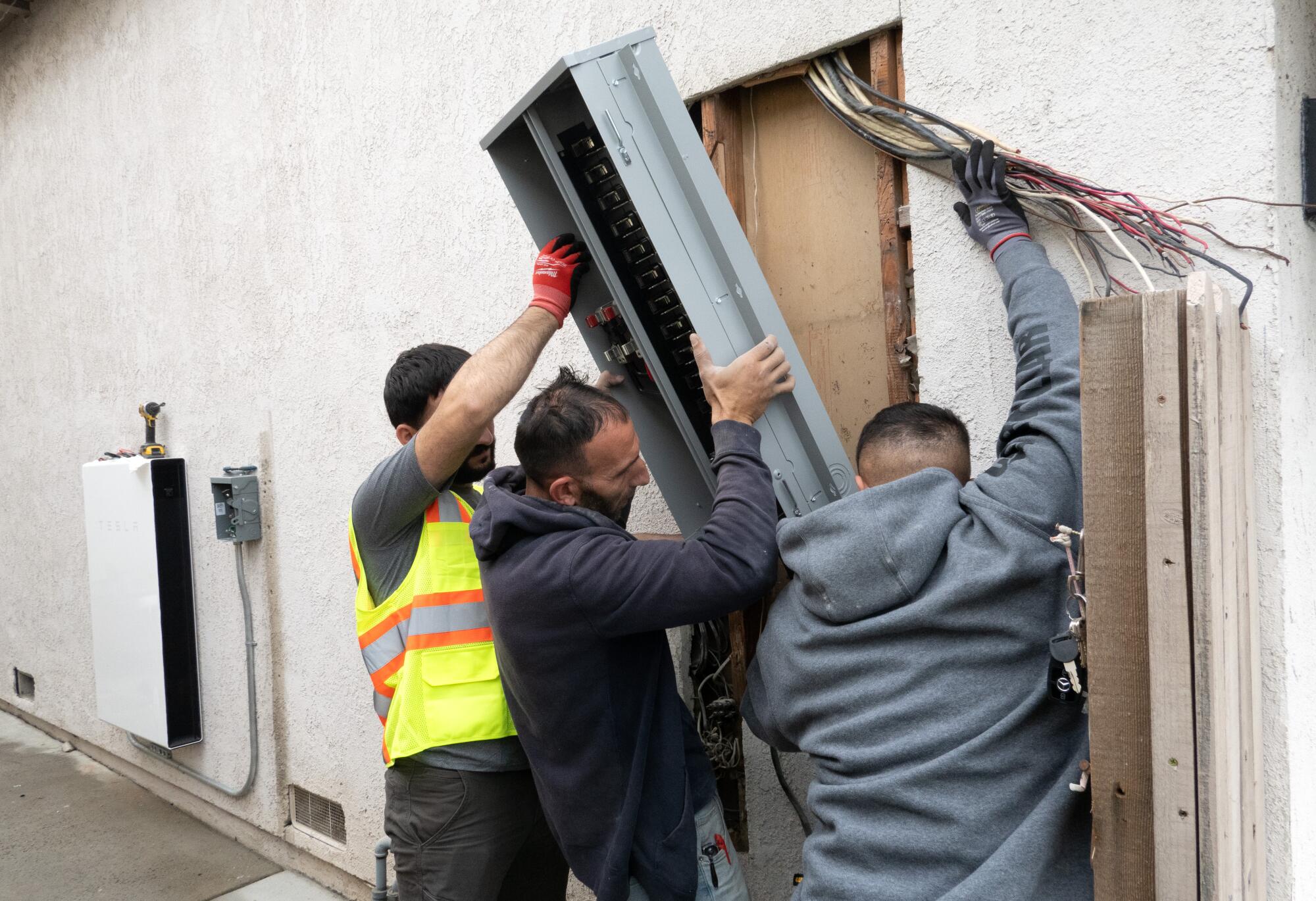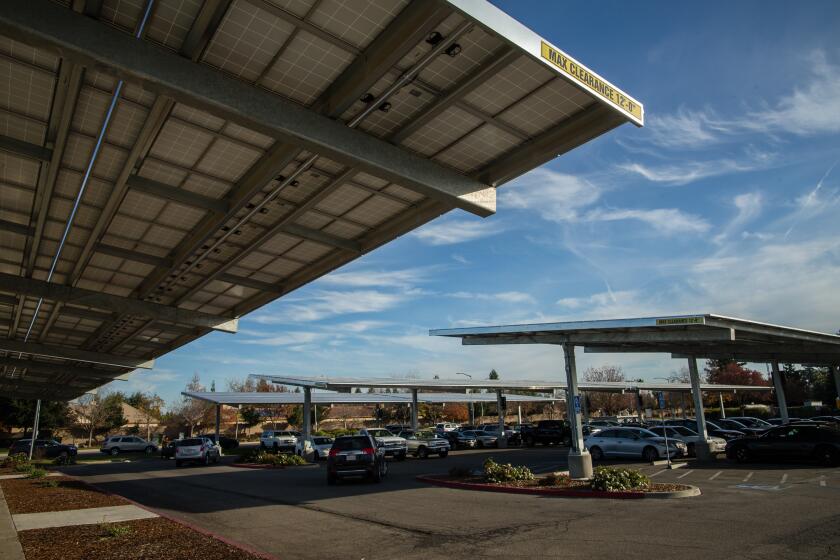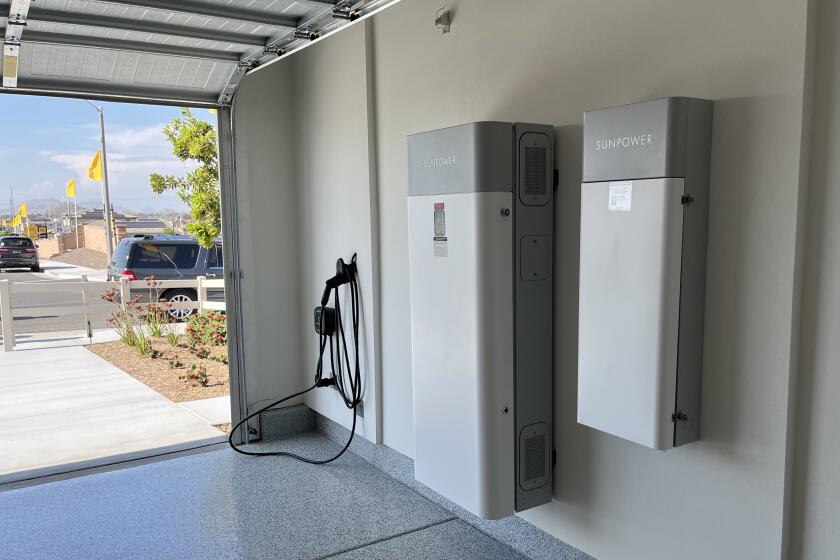
- Share via
Figuring out whether rooftop solar would work for your home has always been complicated, involving factors like the size and shape of your roof and the monthly amount you pay for electricity — not just now, but for the coming 20 to 30 years.
Now, add one more wrinkle.
Starting April 15, one of the main incentives for rooftop solar — the fees that three of the biggest utilities paid homeowners for the extra electricity that their solar panels generated — plummeted by roughly 75%. The California Public Utilities Commission, which ordered the change, said the previous “net metering” fees had forced millions of Californians who didn’t have solar panels to subsidize the ones who did.
(The PUC’s action applied only to Southern California Edison, Pacific Gas & Electric and San Diego Gas & Electric. Municipal utilities like the Los Angeles Department of Power and Water set their own net metering rates.)
Editorial: California needs a lot more solar. Why not put panels along highways and parking lots?
A bill in the state Legislature offers a plan to begin using these already built areas to increase renewable energy.
“The value of solar did just drop overall,” said Bernadette Del Chiaro, executive director of the California Solar & Storage Assn. “There’s no way to sugarcoat that or get around it. But the real question for consumers is whether there is still enough value in the investment.”
Not surprisingly, she argues that there is enough value, whether you buy the panels or purchase the power from a third party. “With ongoing blackouts and rising prices,” she said, “the hope is that consumers don’t totally abandon the technology.”


The new rules mean it will take longer to recoup the money you spend on rooftop solar. But the economics improve if you add a storage battery to your system, which would let you draw less power from the utility grid during costly peak hours after the sun goes down.
Be forewarned, though — like solar panels, batteries are not cheap.
General Manager Kyle Smith of Solar Optimum, a solar installer based in Glendale, said the new rules are “just an all-out attack” on rooftop solar. “You have to have batteries now for it to financially make sense,” he said, which raises the upfront cost and probably delays the break-even point of the investment.
To help you sort through all the factors that will determine whether solar panels are right for your home, The Times talked with experts from the industry and government. Here are their pointers.
The new deal terms
Solar panels produce much of their energy in the middle of the day — when you may not be home to use it. Demand for electricity climbs as the sun drops out of the sky, which is also the time that the power supplied by rooftop solar panels is fading to black.
Hence, the panels swing from generating more power than your home needs to less, over and over again. The excess power gets sent back to your local utility’s electrical grid at the “net metering” rate. Until April 15, 1 watt of excess power from your panels could buy you 1 watt of power from the grid, which made it straightforward to design and install a rooftop solar system that could wipe out the electric bill from your utility.
If the Golden State is going to lead the world toward a better, safer future, our political and business leaders — and the rest of us — will have to work harder to rewrite the California narrative. Here’s how we can push the state forward.
And under the old rules, panel owners sold a lot of electricity back to the grid. According to data collected by the PUC, Edison customers exported 44% of the power their panels generated, PG&E customers exported 50%, and SDG&E customers exported 64%.
Under the new rules, formally known as Net Energy Metering 3.0, the three investor-owned utilities will pay a wholesale rate for the excess power generated by rooftop solar. The wholesale rate varies over the course of a day and is much higher in the early evening — when solar panels have little to offer. During the peak sun hours, 1 watt of excess solar power will buy only about a one-sixth watt of energy from the grid.
Michael Campbell, a program manager at the PUC’s Public Advocates Office, said the old system forced utilities to pay more for the excess power than it was worth to them. The result, he said, was that too much of the cost of transmitting electricity and improving grid safety was pushed onto people who did not have solar panels.
Even supporters of the change agree that it will make solar power less attractive financially. According to the solar industry, the old rates enabled solar panel buyers in Edison’s and PG&E’s territory to recoup their investment in five to six years. Now, the PUC estimates the payback period for Edison customers will be about nine years.
With another heat wave straining California’s electrical grid, it’s a good time to think about how to keep the power on during a blackout. There’s no cheap fix.
It could have been worse for solar: The PUC had proposed to levy a “grid participation charge” on panel owners of up to $8 per kilowatt of rooftop generating power, but that proposal was dropped from the final rules.
In addition, Campbell said, the PUC assumed that utilities will raise their rates 5% a year, but that’s probably too conservative; for example, he noted that Edison has asked for a 23% increase in its base rates for 2025. As a result, he said, an investment in panels should pay for itself sooner than the PUC projected.
(The DWP gives its customers credit for the power their panels generate on a watt-for-watt basis. If they generate more than they consume from the DWP in a month, they’ll still have to pay the utility’s minimum service charges and taxes. But they won’t pay anything for the watts they took from the grid, and they’ll receive a credit calculated at the retail rate they pay, which can offset the cost of future electricity use.)
The battery-powered life
Solar power is seen as one key to the renewable energy future, but rooftop solar has one glaring problem: It generates too much power when it isn’t needed, and too little when the demand for power is straining the grid.
To tackle that issue, NEM 3.0 provides a strong incentive to add high-capacity batteries to rooftop systems to store the excess power generated during the daytime. You might think of a battery as a cool thing to have during a blackout, and indeed it is. But it’s also a way to time-shift solar power from day to night. That way, if you’re running your clothes dryer at 9 p.m., you won’t have to pay your utility’s peak prices. And if you have extra power, you can sell it to the grid when wholesale prices are much higher — and the utilities really need the extra capacity.

Batteries such as the Tesla Powerwall cost notably less than a Tesla, but a heck of a lot more than a pack of Energizer AAs. Prices for the battery start around $7,500, not counting the 30% federal tax credit. According to EnergySage, a Boston-based online marketplace for clean-energy technology, a fully installed home storage rig will cost $10,000 to $20,000.
Before you rattle off all the other wonderful things you could do with $10,000 to $20,000, consider this: According to the PUC, adding a battery to your rooftop solar system will boost your savings by more than a third on average, from about $100 a month to at least $136. As a result, the commission estimated that it would take a wee bit less time for a solar-plus-battery system to pay for itself than a panels-only system would — for Edison customers, about six weeks less. (For its part, Edison says the payback period for a rooftop system with a battery would be 6.6 years, which Smith of Solar Optimum described as a “best-case scenario.”)
Part of the cost of adding a battery is the extra equipment needed to ensure your home can run just on battery power in a lengthy blackout. If you’re willing to dispense with backup power and use the battery just to cut your utility bill, Smith said, you can cut your battery costs by 20% or more.
To ease the sticker shock, the investor-owned utilities offer rebates for home battery systems connected to the grid. Edison is currently offering 15 cents per watt-hour of storage capacity, which, for a 10-kilowatt-hour battery, translates to $1,500. (Southern California Gas offers 20 cents.) For low-income households and homeowners in areas with high fire risk or multiple blackouts, the incentive rises to 85 cents, enough to cover most of the cost of a battery. But the rebates decline as more people sign up for them.
Those subsidies originally came from ratepayers. Last year the state Legislature approved $270 million in battery subsidies, but Gov. Gavin Newsom’s latest budget proposal cuts that funding in the coming fiscal year. Instead, the budget includes $630 million in subsidies for solar panels and batteries for low-income households, the details of which are still being worked out.
How much power your roof can provide
Before going any further, ask yourself why you’re interested in solar panels. If the survival of the planet is your sole concern, feel free to skip ahead to the next section. You’re committed to going solar; all that’s left to be decided is how to pay for it.
For most people, however, the No. 1 goal is to rein in their growing electricity bill, said Vikram Aggarwal, founder and chief executive of EnergySage. Climate and the environment are definitely on people’s minds, he said, but they “don’t usually drive the purchasing decision.”
To get a rough idea of how much you can save by going solar, start by looking at your utility bills to see how much power you’ve been using over the last year and how much you’ve paid for it. Then — and this is the part you’ll probably need some help with — calculate how much electricity your panels could generate.
Your roof’s generating capacity is a function of how much sunlight it receives and how much space it has for solar panels, especially on its southern and western exposures (the first sees the most sunlight; the second can generate power late in the afternoon when electricity rates are higher). One other factor is the wattage level of your panels, which can range from 250 watts to 400 watts.

You can try to run the numbers yourself — see, for example, the DIY guidance from EnergySage — or you can invite a few solar-power installers to pay a visit and give you an estimate. There are also websites aplenty that can help you estimate your roof’s generating capacity, most of which demand your contact information so they can refer you to solar salespeople. One that doesn’t is Google’s Project Sunroof, which offers an estimate of your power-generating ability and your potential savings.
Bear in mind that the panels are typically 65 inches long and 39 inches wide, and you can’t install them over protrusions (e.g., the vent from a fan). Direct sunlight works best, so if your roof is shaded by trees or by tall buildings, you won’t get as much power from your panels.
Aggarwal said that homeowners typically have enough roof space to meet 60% to 80% of their electricity needs with solar panels, and that’s a high enough percentage to seal the deal. In fact, by EnergySage’s calculations, you can save just as much over 20 years with a system that meets 60% of your energy needs as a larger, more expensive one that meets 100%. When the share gets down to the 30% range, however, that’s when people start to balk, Aggarwal said.
One other thing to ponder is whether your roof can last as long as a new set of solar panels, because if you have to replace the roof after the panels are installed, you’ll need to remove them and reinstall them — a process that costs several thousand dollars, the RoofGnome website reports. Roof life spans depend on the type of shingles used; most types last 15 to 30 years. The estimated life span of a solar panel is 30 to 35 years, according to the U.S. Department of Energy.
If you want to go fully solar, you’ll also have to consider how your electricity use will change in the coming years. Planning to trade your car for an electric one? Switch from gas to electric heating? Add a pool or a hot tub? Any of these moves will require more panels on your roof; to see how to calculate an electric vehicle’s thirst for power, check out the guide on Solar.com.
Two routes to rooftop solar
The average amount of electricity used by California households ranges between 500 and 600 kilowatt-hours per month. According to EnergySage, you could generate that much electricity with a 5-kilowatt rooftop solar system, which would cost about $15,000 in California. With the 30% federal tax credit, the cost drops to roughly $11,000. But if you add a battery, your costs could double, according to EnergySage.
Low-income homeowners in eligible neighborhoods can apply to the Disadvantaged Communities — Single-family Affordable Solar Homes program for help buying solar panels, if funds are still available. Financial incentives of up to $3,000 per kilowatt — which may be enough to cover the cost of solar panels — are available to customers of Edison, PG&E and SDG&E in the state’s 25 most disadvantaged communities.
If you’re not eligible for the subsidies, you’ll have to choose whether to own a rooftop system or let a third party put one on your roof to generate power for you. Community solar — in which panels are put on another property and then shared — is another possibility, but it’s in its infancy.
Buying the panels yourself. Financial advisors agree that it’s best to own the panels on your roof, if you can afford to do so. Real estate agents add that it’s much easier to sell your house if the solar panels have been paid for, rather than leased. And multiple studies and surveys have found that solar panels increase the value of your home, although just how much is up for debate.
May Lam Kunka, a real estate agent with Compass in Pasadena, said rooftop solar is “a nice checklist item” for home buyers, “but I don’t think it holds that much weight. Predominantly, they’re looking for location, layout, size and condition. ... Solar, it’s just the added bonus.”
The federal government’s 30% tax credit isn’t matched by the state. Instead, California offers property tax breaks for solar systems, said Neela Hummel, a certified financial planner in Santa Monica: The value of the rooftop solar system you install will be excluded from your property tax assessment. So even if you spend $20,000 or more to go solar, your home won’t be reassessed, nor will the $20,000 be added to your home’s value for tax purposes.
Unless you happen to have that much cash to spare, though, you’ll have to borrow money, which is costlier now that interest rates are relatively high. Hummel said a home equity line of credit is probably the best option, because the interest rate could go down over the course of the project if inflation subsides. You’d need to have enough equity in your home, though, to back up your borrowing.
If not, one option is a “solar” loan — a type of personal loan for home improvement whose interest rate is tied to your credit rating. For example, SoFi offers one with interest rates ranging from about 9% to almost 26%, which is higher than you might pay on your credit card balance. But if you go this route, make sure to get more than one quote and take a hard look at the financing details, said Timothy Mulroy, a wealth management advisor for Northwestern Mutual. For example, he said, a solar loan might show an interest rate of 4%, but you might not realize that hefty fees were added to the purchase price to buy down the rate.
One thing you can do with a solar loan, Hummel said, is break it into parts — one sized to match the amount of the tax credit you’ll receive, the other to cover the rest of the cost. That way, you can pay off the first part as soon as you get your tax refund.
A third option is Property Assessed Clean Energy financing, which you repay through assessments on your property tax bill. Although it tends to offer low interest rates and long repayment periods, the program has drawn so many complaints from homeowners that Los Angeles County no longer offers it. (It’s still available in the county through a slew of other sponsors.) One other point of caution from state regulators: A PACE loan is attached to your property, not to you, which can make your home harder to sell.
Buying just the power. There are two relatively common ways to substitute rooftop solar for the local utility’s electricity without having to buy panels: lease deals and solar power purchase agreements. In both cases, solar panels will be installed on your roof, but they will be owned and maintained by a solar energy company.
So instead of a big upfront cost, you’ll face a long-term commitment to pay for power that’s cheaper than what your utility supplies — assuming that utility rates keep going up. It’s a problem if they don’t, because lease deals and purchase agreements typically raise the fees you pay every year by a few percentage points.
Leases typically run for 20 to 25 years. Afterward, you may have the option to buy the panels at a discount (although they will be approaching the end of their useful life). Otherwise, off they go. While they’re on your roof, you’ll pay a monthly fee to use whatever power they generate.
In a power purchase agreement, you’ll be able to buy power at a discount for 20 to 25 years, paying just for what you use. The more power you buy through the PPA instead of your utility, the greater the savings.
The PUC’s new rules have thrown a wrench into these deals by paying substantially less for the excess power the panels generate during prime daylight hours. So companies are encouraging customers to add batteries to their systems, Aggarwal of EnergySage said, so they can sell it to the grid later in the day when rates are higher.
For example, Sunrun’s main offer in California now is a PPA that includes a battery — not for backup power, but to store power for sale later in the day, said Paul Dickson, the company’s chief revenue officer. The cost of the battery means Sunrun customers don’t get as big a discount on their electricity as before, he said, but most solar customers in California are still able to save 10% to 30% or more.
Mulroy said leases and purchase agreements may be the way to go for people who can’t afford to pay cash for a rooftop system and have a low credit score, which would raise their borrowing costs. Such deals might also make sense for people who don’t owe any federal taxes, and so couldn’t take advantage of the big federal tax credit, he said.
One important caveat for leases and purchase agreements: If you have to move or just want out of the deal, you’ll face a hefty early termination fee. And you probably shouldn’t count on prospective home buyers to rescue you from your contract.
“In general, home buyers are leery of taking over leases, so again another strike against leases,” Hummel said. “If you’re going to be selling your house in three years, maybe now is not the time to invest in solar.”
Ask a Reporter: Inside the project
What: Times reporters Rosanna Xia and Sammy Roth will discuss “Our Climate Change Challenge” during a live streaming conversation. City Editor Maria L. LaGanga moderates.
When: Sept. 19 at 6 p.m. Pacific.
Where: This free event will be live streaming. Sign up on Eventbrite for watch links and to share your questions and comments.












